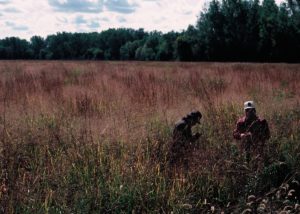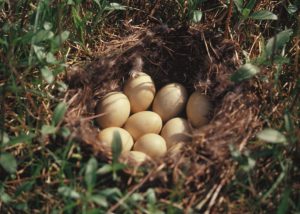For the Love of the Wild: Livestock Pastures as Wildlife Habitat
Our agricultural landscapes are habitat for wildlife, and we have a large toolbox of practices that can help us be better stewards of our land and all its inhabitants. One of these tools is adaptive grazing.

Warm-season grasses provide wildlife habitat and excellent livestock forage.
Image by NRCS
Farmers, ranchers, and researchers have come to understand the functionality of ecosystems on farms is largely dependent on plant and animal biodiversity. Functional ecological processes and services, such as soil and water quality, renewal and regeneration of soil and plant organisms, and nutrient cycling on farms and ranches, are facilitated by biology, necessitating maintenance of biological integrity and diversity in agroecosystems (Altieri, 1999). It is not surprising that adaptive multi-paddock grazing is an effective conservation practice on grazing lands for enhancing water conservation and protecting water quality (Park et al., 2017), as well as enhancing soil carbon, fertility, and soil water-holding capacity (Teague and Barnes, 2017) that soil organisms rely on for building healthy soil.
But there is another aspect of biodiversity that is just as important as soil and plant organisms. Livestock and wildlife compete for landscape resources, and they both put pressure on the forage available, as well as water, cover, and space, depending on their resource needs. In fact, wildlife species often “require considerably greater amounts of space to achieve acceptable levels of reproductive performance whereby survival of a population is assured” (Barnes et al., 1991). Birds need cover and shelter during their reproductive phase, and deer and elk need forage, cover, water, and a range large enough for them to thrive. Small mammals need space and protection from predators, and fish need quality streams and ponds. The concepts of resource supply and demand are just as important for wildlife as they are for livestock, and this affects our grazing management.
Historically, livestock have been a destructive force on landscapes (Ohmart, 1996), but they don’t have to be. Our agricultural landscapes are habitat for wildlife, connected and ecologically linked to set-aside wild lands, parks and reserves, wetlands and riparian zones, abandoned farms, privately owned non-agricultural forests and fields, and peri-urban low-density residential areas, which make up a large portion of the land in many areas. The ecology of our lands has changed over time due to invasive species, exotic species, removal of large carnivores, and human encroachment. But farmers and landowners have become better wildlife stewards, and many include wildlife habitat into their whole- farm plans out of love of the wild and for quiet woods and fields populated with majestic creatures. And they invite friends and neighbors into the woods to see and reflect on the wildness that constitutes an important part of their farm.

Nest located on land where NRCS has provided technical assistance to landowners in the prairie pothole region of northeastern South Dakota.
Image by NRCS
We have a large toolbox of practices that can help us be better stewards of our land and all its inhabitants. One way of including wildlife in farm planning is to manage plant succession to favor diversity that is beneficial for wildlife. The desired plant community for a diverse population of wildlife species is one comprised of a diversity of grasses, forbs, and woody plants interspersed across the landscape and having different structures in terms of size, growth form, and physical maturity (Stevens, 2016). Livestock grazing can be used to manipulate various paddocks to maintain different habitats throughout the grazing season. For example, habitat requirements vary seasonally for nesting, breeding, feeding, etc. for different wildlife species. Standing vegetation is often best for nesting birds but grazed diverse vegetation is good for feeding sites (Vavra, 2005). This is just one example of including practices that take wildlife into consideration.
An adaptive grazing system, because of its inherent flexibility, can be compatible with wildlife habitat management by mimicking the seasonal movement of species based on forage quality and quantity (Schieltz and Rubenstein, 2016). It can foster diverse landscapes at various times of the year by manipulating animal numbers in paddocks, grazing some paddocks heavily and some lightly, and some perhaps not at all for a part of the season, leaving diverse grasses and forbs ungrazed for a part of the year for wildlife.
There are many resources to help farmers, ranchers, and landowners foster wildlife habitat on their land, including the U.S. Fish and Wildlife Partners Program, which works with private landowners to plan and implement on-farm projects to create, restore, or enhance habitat for wildlife. Farmers and ranchers are telling their own stories of restoration of the land for its own sake, much like Meredith Ellis, a second-generation Texas rancher, put it better than anyone I’ve heard when she said species diversity and rare species are indicators that you’re doing something right (Ellis, 2021).

